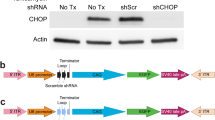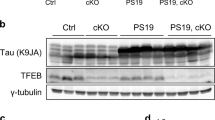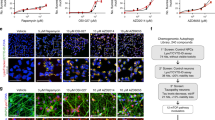Abstract
Emerging studies suggest a role for tau in regulating the biology of RNA binding proteins (RBPs). We now show that reducing the RBP T-cell intracellular antigen 1 (TIA1) in vivo protects against neurodegeneration and prolongs survival in transgenic P301S Tau mice. Biochemical fractionation shows co-enrichment and co-localization of tau oligomers and RBPs in transgenic P301S Tau mice. Reducing TIA1 decreased the number and size of granules co-localizing with stress granule markers. Decreasing TIA1 also inhibited the accumulation of tau oligomers at the expense of increasing neurofibrillary tangles. Despite the increase in neurofibrillary tangles, TIA1 reduction increased neuronal survival and rescued behavioral deficits and lifespan. These data provide in vivo evidence that TIA1 plays a key role in mediating toxicity and further suggest that RBPs direct the pathway of tau aggregation and the resulting neurodegeneration. We propose a model in which dysfunction of the translational stress response leads to tau-mediated pathology.
This is a preview of subscription content, access via your institution
Access options
Access Nature and 54 other Nature Portfolio journals
Get Nature+, our best-value online-access subscription
$29.99 / 30 days
cancel any time
Subscribe to this journal
Receive 12 print issues and online access
$209.00 per year
only $17.42 per issue
Buy this article
- Purchase on Springer Link
- Instant access to full article PDF
Prices may be subject to local taxes which are calculated during checkout







Similar content being viewed by others
References
Gitler, A. D. & Shorter, J. RNA-binding proteins with prion-like domains in ALS and FTLD-U. Prion 5, 179–187 (2011).
Ash, P. E., Vanderweyde, T. E., Youmans, K. L., Apicco, D. J. & Wolozin, B. Pathological stress granules in Alzheimer’s disease. Brain Res. 1584, 52–58 (2014).
Banani, S. F., Lee, H. O., Hyman, A. A. & Rosen, M. K. Biomolecular condensates: organizers of cellular biochemistry. Nat. Rev. Mol. Cell Biol. 18, 285–298 (2017).
Feric, M. et al. Coexisting liquid phases underlie nucleolar subcompartments. Cell 165, 1686–1697 (2016).
Anderson, P. & Kedersha, N. Stress granules: the Tao of RNA triage. Trends Biochem. Sci. 33, 141–150 (2008).
Panas, M. D., Ivanov, P. & Anderson, P. Mechanistic insights into mammalian stress granule dynamics. J. Cell Biol. 215, 313–323 (2016).
Irwin, D. J. et al. Frontotemporal lobar degeneration: defining phenotypic diversity through personalized medicine. Acta Neuropathol. 129, 469–491 (2015).
Jain, A. & Vale, R. D. RNA phase transitions in repeat expansion disorders. Nature 546, 243–247 (2017).
Patel, A. et al. A liquid-to-solid phase transition of the ALS protein FUS accelerated by disease mutation. Cell 162, 1066–1077 (2015).
Nott, T. J. et al. Phase transition of a disordered nuage protein generates environmentally responsive membraneless organelles. Mol. Cell 57, 936–947 (2015).
Molliex, A. et al. Phase separation by low complexity domains promotes stress granule assembly and drives pathological fibrillization. Cell 163, 123–133 (2015).
Lin, Y., Protter, D. S., Rosen, M. K. & Parker, R. Formation and maturation of phase-separated liquid droplets by RNA-binding proteins. Mol. Cell 60, 208–219 (2015).
Vanderweyde, T. et al. Interaction of tau with the RNA-binding protein TIA1 regulates tau pathophysiology and toxicity. Cell Rep. 15, 1455–1466 (2016).
Vanderweyde, T. et al. Contrasting pathology of the stress granule proteins TIA-1 and G3BP in tauopathies. J. Neurosci. 32, 8270–8283 (2012).
Wang, Y. & Mandelkow, E. Tau in physiology and pathology. Nat. Rev. Neurosci. 17, 5–21 (2016).
Yoshiyama, Y. et al. Synapse loss and microglial activation precede tangles in a P301S tauopathy mouse model. Neuron 53, 337–351 (2007).
Phillips, K., Kedersha, N., Shen, L., Blackshear, P. J. & Anderson, P. Arthritis suppressor genes TIA-1 and TTP dampen the expression of tumor necrosis factor alpha, cyclooxygenase 2, and inflammatory arthritis. Proc. Natl. Acad. Sci. USA 101, 2011–2016 (2004).
Takeuchi, H. et al. P301S mutant human tau transgenic mice manifest early symptoms of human tauopathies with dementia and altered sensorimotor gating. PLoS One 6, e21050 (2011).
Lalonde, R. The neurobiological basis of spontaneous alternation. Neurosci. Biobehav. Rev. 26, 91–104 (2002).
Cohen, S. J. & Stackman, R. W. Jr. Assessing rodent hippocampal involvement in the novel object recognition task. A review. Behav. Brain Res. 285, 105–117 (2015).
Abraha, A. et al. C-terminal inhibition of tau assembly in vitro and in Alzheimer’s disease. J. Cell Sci. 113, 3737–3745 (2000).
Ding, H., Matthews, T. A. & Johnson, G. V. Site-specific phosphorylation and caspase cleavage differentially impact tau-microtubule interactions and tau aggregation. J. Biol. Chem. 281, 19107–19114 (2006).
Rocher, A. B. et al. Structural and functional changes in tau mutant mice neurons are not linked to the presence of NFTs. Exp. Neurol. 223, 385–393 (2010).
Santacruz, K. et al. Tau suppression in a neurodegenerative mouse model improves memory function. Science 309, 476–481 (2005).
de Calignon, A. et al. Caspase activation precedes and leads to tangles. Nature 464, 1201–1204 (2010).
Sanders, D. W. et al. Distinct tau prion strains propagate in cells and mice and define different tauopathies. Neuron 82, 1271–1288 (2014).
Kuchibhotla, K. V. et al. Neurofibrillary tangle-bearing neurons are functionally integrated in cortical circuits in vivo. Proc. Natl. Acad. Sci. USA 111, 510–514 (2014).
Sahara, N. et al. Characteristics of TBS-extractable hyperphosphorylated tau species: aggregation intermediates in rTg4510 mouse brain. J. Alzheimers Dis. 33, 249–263 (2013).
Berger, Z. et al. Accumulation of pathological tau species and memory loss in a conditional model of tauopathy. J. Neurosci. 27, 3650–3662 (2007).
Combs, B., Hamel, C. & Kanaan, N. M. Pathological conformations involving the amino terminus of tau occur early in Alzheimer’s disease and are differentially detected by monoclonal antibodies. Neurobiol. Dis. 94, 18–31 (2016).
Huang, W., Sherman, B. T. & Lempicki, R. A. Systematic and integrative analysis of large gene lists using DAVID bioinformatics resources. Nat. Protoc. 4, 44–57 (2009).
Li, Y. R., King, O. D., Shorter, J. & Gitler, A. D. Stress granules as crucibles of ALS pathogenesis. J. Cell Biol. 201, 361–372 (2013).
Wolozin, B. Regulated protein aggregation: stress granules and neurodegeneration. Mol. Neurodegener. 7, 56 (2012).
Dobson, C. M. Protein folding and misfolding. Nature 426, 884–890 (2003).
Li, P. et al. Phase transitions in the assembly of multivalent signalling proteins. Nature 483, 336–340 (2012).
Maziuk, B., Ballance, H. I. & Wolozin, B. Dysregulation of RNA binding protein aggregation in neurodegenerative disorders. Front. Mol. Neurosci. 10, 89 (2017).
Taylor, J. P., Brown, R. H. Jr. & Cleveland, D. W. Decoding ALS: from genes to mechanism. Nature 539, 197–206 (2016).
Banani, S. F. et al. Compositional control of phase-separated cellular bodies. Cell 166, 651–663 (2016).
Brunello, C. A., Yan, X. & Huttunen, H. J. Internalized Tau sensitizes cells to stress by promoting formation and stability of stress granules. Sci. Rep. 6, 30498 (2016).
Meier, S. et al. Pathological Tau promotes neuronal damage by impairing ribosomal function and decreasing protein synthesis. J. Neurosci. 36, 1001–1007 (2016).
Zhang, X. et al. RNA stores tau reversibly in complex coacervates. PLoS Biol. 15, e2002183 (2017).
Zempel, H. & Mandelkow, E. Lost after translation: missorting of Tau protein and consequences for Alzheimer disease. Trends Neurosci. 37, 721–732 (2014).
Ling, S. C., Polymenidou, M. & Cleveland, D. W. Converging mechanisms in ALS and FTD: disrupted RNA and protein homeostasis. Neuron 79, 416–438 (2013).
Darnell, R. B. RNA protein interaction in neurons. Annu. Rev. Neurosci. 36, 243–270 (2013).
Leger, M. et al. Object recognition test in mice. Nat. Protoc. 8, 2531–2537 (2013).
Acknowledgements
We thank P. Davies (Feinstein Institute) for provision of CP13 and PHF1 antibodies. We thank the following funding agencies for their support: B.W. received support from the NIH (AG050471, NS089544 and ES020395), BrightFocus Foundation, Alzheimer Association, Cure Alzheimer’s Fund and the Thome Medical Foundation; U.D. received support from a UGC-Raman Fellowship and the Government of India; T.I. received support from the NIH (R01 AG054199); H.L. received support from the Paul F. Glenn Foundation.
Author information
Authors and Affiliations
Contributions
D.J.A. conceived, performed and analyzed experiments and wrote the original draft; P.E.A.A. performed and analyzed experiments; B.M., C.L., M.M., A.A.A., E.B., H.B., D.K., A.W., L.R.G., N.Y. and J. Leszyk performed experiments; A.F.F., C.Z., C.Y.U., N.M.K., T.I., P.C., J. Luebke, H.L. and C.B. provided expertise and edited the manuscript; and B.W. conceived, analyzed, wrote the original draft, edited, supervised and provided funding for the project.
Corresponding author
Ethics declarations
Competing interests
B.W. is co-founder and Chief Scientific Officer for Aquinnah Pharmaceuticals Inc.
Additional information
Publisher’s note: Springer Nature remains neutral with regard to jurisdictional claims in published maps and institutional affiliations.
Integrated supplementary information
Supplementary Figure 1 TIA1 reduction decreases cytoplasmic TIA1 granules in PS19 mice
A. IHC of cytoplasmic TIA1 granules (green, arrows) and DAPI (blue) in 6 month P301S Tia1+/+ and P301S Tia1+/- hippocampus (CA3). Scale bar = 5 |am. B. Quantification of number of TIA1 granules per cell in A. *p = 0.0394 (WT Tau Tia1+/+ vs WT Tau Tia1+/-) and *p = 0.0270 (P301S Tia1+/+ vs P301S Tia1+/-) by unpaired Student's T-test (one-tailed; n=4 mice/group, at least 20 cells imaged per mouse).
Supplementary Figure 2 TIA1 reduction protects against presynaptic and axonal degeneration up to 9 months of age in P301S Tau mice
A. IHC of NeuN (blue), synaptophysin (SYP, green), and neurofilament (NFL, red) in 9 month non-transgenic (WT Tau), PS19 (P301S Tau) and PS19 (P301S Tau) Tia1+/- hippocampus (CA3). Scale bar = 20 urn. B-C. Quantification of total SYP (B) and NFL (C) immunofluorescence in P301S Tia1+/+ and P301S Tia1+/- mice in A. SYP, unpaired Student's T-test (two-tailed) of P301S Tia1+/+ vs P301S Tia1+/-, *p=0.0491, N=10-13/group. NFL, unpaired Student's T-test (two-tailed) of P301S Tia1+/+ vs P301S Tia1+/-, *p=0.0441, N=11-12/group. Error bars denote means ± SEM normalized to wildtype levels equal to 1.
Supplementary Figure 3 TIA1 reduction increases tau binding to microtubules
A. Microtubule (MT)-bound and unbound fractions of P301S Tia1+/+ and P301S Tia1+/- cortex were separated by ultracentrifugation in RAB buffer. MT-bound (pellet, P) and MT-unbound (supernatant, S) fractions were immunoblotted for Tau13 (detects total human tau, top panels) and a-tubulin (bottom panel) to confirm efficient separation of MT elements in the S and P fractions. Top and middle panels represent longer and shorter exposure times of Tau13 immunoblot, respectively.
Supplementary Figure 4 TIA1 reduction protects against tau mediated neurodegeneration in the lateral entorhinal cortex
A. Quantification of the number of Nissl-positive neurons per field in layer II/III LEnt of 9 month non-transgenic (WT Tau) and PS19 (P301S Tau) mice. *p<0.05 by 2-way between-subjects ANOVA with Tukey's post-hoc tests (n=6/group). B. Quantification of average layer II/III cortical thickness in 9 month LEnt. **p=0.0095 ***p<0.001 by 2-way between-subjects ANOVA with Tukey's post-hoc tests (n=8 or more per/group). Error bars represent means ± SEM.
Supplementary Figure 5 PS19 mice exhibit increased number of arm entries in the Y maze
A. Number of arm entries in the Y maze spontaneous alternation task (SAT) over a 10 minute experimental period. **p=0.0086, *p=0.0312 by 2-Way between-subjects ANOVA with Tukey's post-hoc comparisons (n=16-20/group). P301S Tia1+/+ and P301S Tia1+/- mice were not significantly different. Error bars denote means ± SEM.
Supplementary Figure 6 PS19 mice exhibit hyperactive locomotor activity and reduced anxiety behaviors independent of Tial genotype
A-D. P301S transgene expression increased distance traveled (A), mean speed (B), and center time (C) in the OF task, while decreasing freezing time (D). Main effect of P301S Tau transgene by 2-way between-subjects ANOVA (p=ns) for total distance traveled, mean speed, center time, and freezing time. Error bars denote means ± SEM.
Supplementary Figure 7 TIA1 reduction elicits a biphasic change in tau phosphorylation in PS19 mice
A. IHC of DAPI (blue), NeuN (green), and CP13 phospho (S202)-tau (red) in 3 (top panels) and 6 (bottom) month CA3 in non-transgenic (WT Tau) and PS19 (P301S Tau) mice. B-C. Quantification of CP13 (from A) and AT8 (S202/T205) phospho-tau immunofluorescence at 3 months in CA1 and CA3. *p<0.05 **p<0.01 by unpaired Student's t-test (n=3-5/group). D. Quantification of CP13 immunofluorescence at 6 months in CA3 from A. **p=0.0044 by unpaired Student's t-test (n=4-5/group). Error bars represent means ± SEM.
Supplementary Figure 8 TIA1 reduction increases levels of phosphorylated tau in aged PS19 mice
A. Immunoblot analysis of PHF1 (S396/S404) phospho-tau, CP13, Tau13 (total tau), and a-tubulin levels in total (RIPA-soluble) brain lysates of 6-month P301S Tia1+/+ and P301S Tia1+/- mice. Each lane corresponds to a different mouse from the cohort. B-C. Quantification of PHF1+ (B), CP13+ (C), and total (D) tau in A. PHF1 and CP13 phospho-tau levels were normalized to total tau levels (Tau13) detected in each sample. #p= 0.0981 *p=0.0276 **p=0.0079 by unpaired Student's t-test (n=3/group). Error bars denote means ± SEM.
Supplementary Figure 9 The number of Gallyas Silver neurofibrillary tangles does not correlate with neuronal loss in 9 month PS19 mice
Number of Gallyas Silver+ tangles plotted against the number of Nissl+ neurons in CA3 of the same animals for 9 month P301S Tia1+/+ and P301S Tia1+/- mice (r2= 0.07).
Supplementary Figure 10 TIA1 reduction decreases soluble tau oligomers in PS19 mice
A-C. Quantification of conformational (TNT1, TOC1) and total tau species in the soluble (S1) fraction of 9 month P301S Tia1+/+ and P301S Tia1+/- cortex, as detected by non-denaturing ELISA using TNT1 (A), TOC1 (B), and Tau5 (C) antibodies. The TNT1 and TOC1 levels plotted in A and B were normalized to the level of Tau5 (total tau) detected in the same sample. Concentrations in each sample were determined by comparison to a standard curve generated from recombinant tau. #p=0.1420 **p= 0.0073 by unpaired Student's t-tests (n=3/group). Error bars denote means ± SEM.
Supplementary Figure 11 RNA binding proteins are enriched in the S1p tau oligomer fraction of PS19 cortex
A. Gene ontology (GO) analysis of proteins identified by OrbiTrap liquid chromatography tandem mass spectrometry (LC-MS/MS) are enriched (FDR < 0.05) for annotation terms related to mRNA binding and RNA metabolism. B. Immunoblot of the RNA binding proteins (RBPs) PABP and DDX6 in the S1p and P3 fractions of P301S Tia1+/+ and P301S Tia1+/- cortex, validating the change identified by LC-MS/MS. Each lane corresponds to a different mouse from the cohort.
Supplementary Figure 12 TIA disrupts fibrillization of pTau
Fibrillization of GSK3|3 phosphorylated recombinant Tau was induced using dextran sulfate (DS) and RNA (pTau+Ctrl). In the presence of recombinant TIA1, pTau fibril length was significantly reduced. BSA was used as a negative control for presence of additional protein in the Tau fibrillization assay. Scatter plot of individual Tau fibril lengths (nm) measured by EM with bar at mean, box representing quartiles and whiskers representing SEM. ANOVA posthoc. *** p<0.001. Numbers assigned to data points in order in which they are measured.
Supplementary Figure 13 TIA1 selectively associates with pre-fibrillar tau aggregates
A. Representative EM image of pTau + TIA1 assembly reaction double immuno-gold labeled with antibodies to TOC1 and TIA1. While TIA1 (15 nm particles) exhibited no labeling of tau fibrils (i), TOC1 (6 nm particles) aggregates (ii) almost always exhibited co-labeling of TIA1. Scale bar = 500 nm.
Supplementary Figure 14 Controls for TOC1 immunohistochemical labeling
TOC1 antibody (green) did not label neurons in frontal cortex in A) WT mice, but did label neurons in B) P301S tau mice (9 months). DAPI = blue. Scale bar = 5 ^m.
Supplementary Figure 15 Model for regulation of tau oligomerization by TIA1
We propose that TIA1 binds and stabilizes oligomeric tau, which is a very toxic form. Reducing TIA1 removes the stabilization and allows greater production of tau fibrils. TIA1 reduction also inhibits the hyperactive stress granule response, which allows TIA1 and other RBPs to re-localize to their normal physiological functions, such as RNA splicing. The reduction in oligomeric tau and rescue of RBP functions associated with reducing TIA1 leads to neuroprotection and increased survival.
Supplementary Figure 16 Full immunoblot image of Figure 1A top panel probing for TIA1
Samples from total brain lysates of 3 month old P301S Tia1+/+ and P301S Tia1+/- mice.
Supplementary Figure 17 Full immunoblot image of Figure 1A bottom panel probing for Actin
Samples from total brain lysates of 3 month old P301S Tia1+/+ and P301S Tia1+/- mice.
Supplementary Figure 18 Full immunoblot image of Figure 2C top panel probing for Tau (Tau13)
Samples from microtubule-bound pellet and unbound supernatant in 6 and 9 month old WT, Tia+/-, P301S Tia1+/+ and P301S Tia1+/- mouse total cortex.
Supplementary Figure 19 Full immunoblot image of Figure 2C bottom panel probing for tubulin
Samples from microtubule-bound pellet and unbound supernatant in 6 and 9 month old WT, Tia+/-, P301S Tia1+/+ and P301S Tia1+/- mouse total cortex.
Supplementary Figure 20 Full immunoblot image of short exposure panels in Figure 6A probing for Tau (Tau13)
Image from short exposure (3mins) of total tau immunoblots of samples from S1p (left) and P3 (right) fractions of 6 and 9 month old P301S Tia1+/+ and P301S Tia1+/- mice.
Supplementary Figure 21 Full immunoblot image of long exposure panels in Figure 6A probing for Tau (Tau13)
Image from long exposure (30mins) of total tau immunoblots of samples from S1p (left) and P3 (right) fractions of 6 and 9 month old P301S Tia1+/+ and P301S Tia1+/- mice.
Supplementary information
Supplementary Table 1
Lifespan data for P301S Tia1+/+ and P301S Tia1+/- mice
Supplementary Table 2
Proteomic components of the S1p fractions of PS19 cortices detected by LC-MS-MS
Supplementary Table 3
Table of absolute p values from statistical tests
Rights and permissions
About this article
Cite this article
Apicco, D.J., Ash, P.E.A., Maziuk, B. et al. Reducing the RNA binding protein TIA1 protects against tau-mediated neurodegeneration in vivo. Nat Neurosci 21, 72–80 (2018). https://doi.org/10.1038/s41593-017-0022-z
Received:
Accepted:
Published:
Issue Date:
DOI: https://doi.org/10.1038/s41593-017-0022-z
This article is cited by
-
Reduced progranulin increases tau and α-synuclein inclusions and alters mouse tauopathy phenotypes via glucocerebrosidase
Nature Communications (2024)
-
Liquid–liquid phase separation in Alzheimer’s disease
Journal of Molecular Medicine (2024)
-
Mid-infrared chemical imaging of intracellular tau fibrils using fluorescence-guided computational photothermal microscopy
Light: Science & Applications (2023)
-
RNA-Binding Proteins: A Role in Neurotoxicity?
Neurotoxicity Research (2023)
-
Transcriptome of the synganglion in the tick Ixodes ricinus and evolution of the cys-loop ligand-gated ion channel family in ticks
BMC Genomics (2022)



